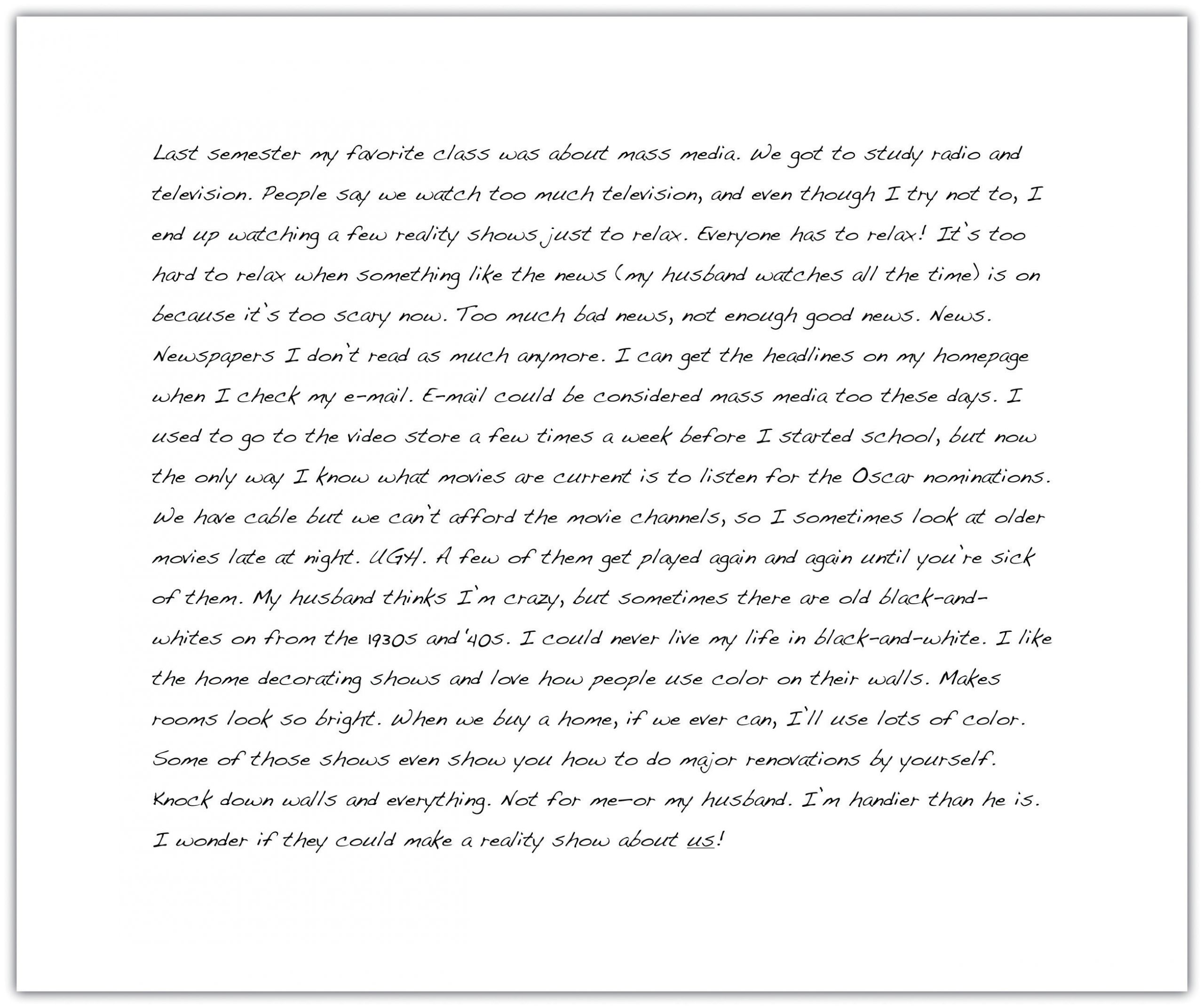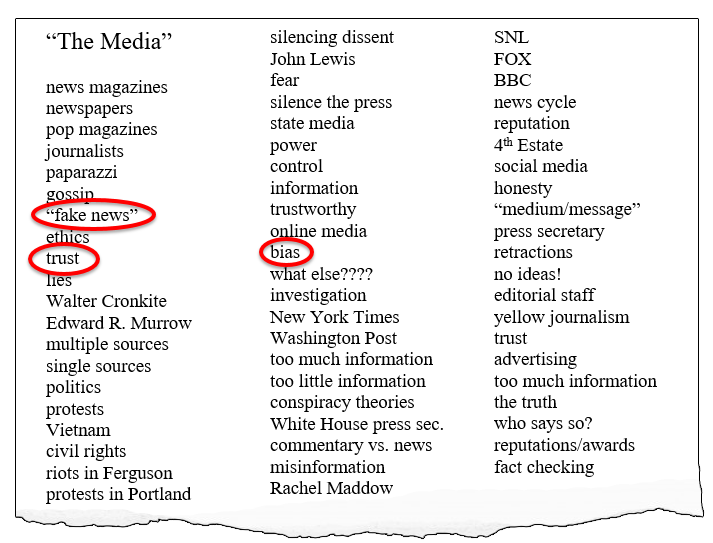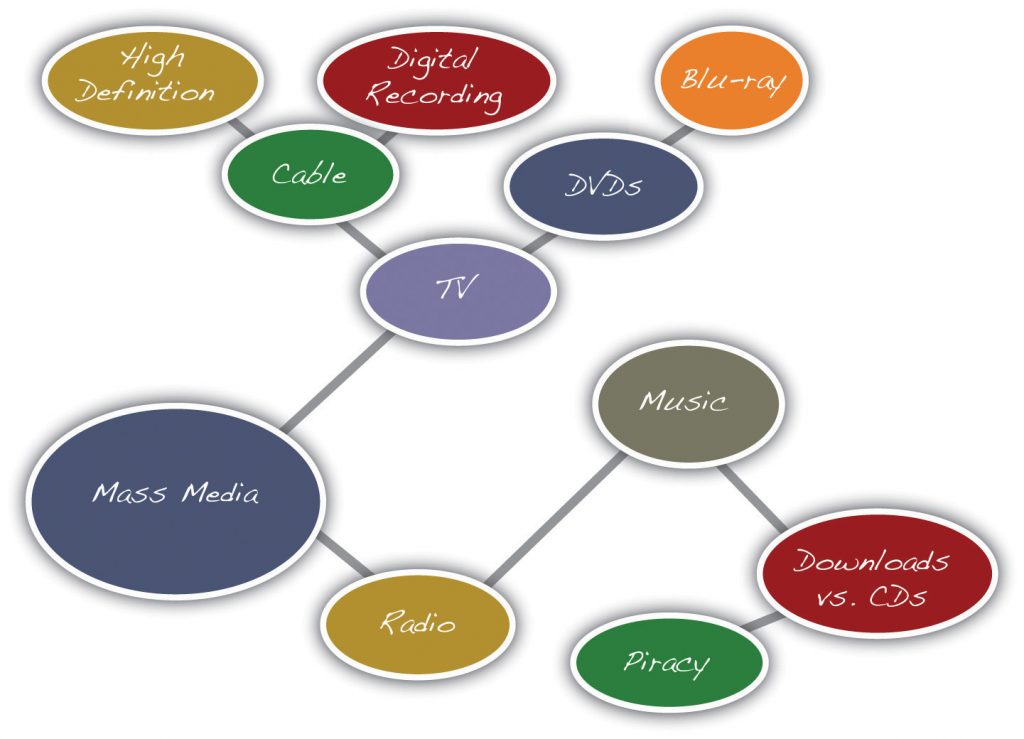65 7.2 Getting Started
Preview
This section of Ch. 7 will introduce the following topics:
- the purpose of prewriting
- four types of prewriting
- choosing a good topic
If you think a blank sheet of paper or a blinking cursor on a blank computer screen is scary, you are not alone. Beginning to write can be intimidating. However, experienced writers remind themselves that writing is a process. Any big project can be accomplished if you take it a step at a time.
Step 1: Prewriting
Prewriting is the first stage of this writing process. Prewriting can help you get started if you don’t know where to begin, it can help you narrow a topic that is too broad, and it can help you explore what you know about your chosen topic and find interesting examples and details to use in your paper. Prewriting is just brainstorming in writing.
We get our ideas from many places: what we read, what we hear, what we see and experience, our imagination. Prewriting helps us turn all of that information into words on a page. Prewriting is a way to think about what you think, to break through mental blocks, to get ideas out of your head and down on paper so you have something with which to work.
There are a few, very simple rules for prewriting:
- Use pencil and paper or a computer, whichever allows you to write more quickly.
- Write your topic at the top of the page to remind yourself to stick to it. If you wander off, just look at your topic and wander back.
- Don’t worry about spelling, punctuation, repetition, or exact wording. Your goal is to simply get as much information on the page as you can.
- Write for 10 minutes. More is unnecessary; less is not enough time to find unexpected ideas.
Don’t stop and start. The value comes from writing uninterrupted for 10 minutes. Keep pushing your brain to come up with one more idea and one more idea. That is when you find interesting and even surprising stuff.
Types of prewriting explained here include Freewriting, Questioning, Listing, and Clustering. Try them all, then use the technique that works best for your thinking process or for the specific assignment you’ve been given.
Freewriting
Freewriting is when you jot down thoughts that come to mind in rough sentences or phrases. Try not to doubt or question your ideas. Allow yourself to write freely. Don’t be self-conscious. Nobody is going to grade this. Once you start writing without limitations, you may find you have more to say than you thought. If you get stuck, look at your topic again and continue.
Here is an example of Freewriting on the topic of “the media.” Notice the writer isn’t worrying about grammar, fragments, or even staying on topic. She is just writing down everything that comes to mind about the media.
Listing
Listing is like Freewriting, but instead of writing across the page, you go from top to bottom, listing topics or details, one after another, without trying to sort or organize.
Here is an example of Listing on the topic of “the media.” Notice the ideas bounce from one to another, then off in a different direction. The point is to get as many ideas on the page as possible.
Exercise 7.1
Do a prewrite on the broad assigned topic of “the COVID-19 pandemic as it relates to your education.”
The goal of a first prewrite is to explore a topic and consider different approaches so that you can narrow the topic and make it your own.
Use either Freewriting or Listing. Follow the directions above and write without stopping for 10 minutes. You should end up with a least two pages full of words.
After you finish, read over what you wrote. Find a few things that might make a good essay. Circle them.
If you did not find a good topic, do another prewrite. If you used Freewriting the first time, try Listing, or vice versa. Do not move on to the next section until you have a couple of potential topics for your first essay.
Remember that your essay must be based on personal experience, not research.
Questioning
Who? What? When? Where? Why? How?
In everyday situations, we pose these questions to get information. Who will be my partner for the project? What do I need to get at the grocery store? Why is my car making that noise? We seek answers to these questions to gain knowledge, to better understand our experiences, and to plan for the future.
In prewriting, answering these questions can help you recall ideas you already have and generate new thoughts about a topic.
To do Questioning, write the words “who, what, when, where, why, how” down the left-hand side of a sheet of paper, leaving space between the words. Then, in the blank space, answer the questions as they relate to your topic in as many ways as you can. Jump down to answer a question, then jump back up to answer a different one. Fill up the page.
Here is an example of Questioning on the topic of “the media”:
| Questions | Responses |
|---|---|
| Who? | Students, teachers, parents, politicians, employees–almost everyone uses media. Who creates media? Journalists, reporters, big companies, political groups. Who else? I guess anyone who wants to share information with others. |
| What? | Lots of things. Television, radio, e-mail (?), newspapers, magazines, books. Is that good? Well, information is good. But how do we know if it is true? I guess we don’t. Maybe we have to know more about who is writing the information. Is Dear Abby media? Are advertisements media? What about false advertising? |
| When? | Media has been around a long time, but seems a lot more important now. Is that because of computers? When did the news move from newspapers to TV to online? |
| Where? | The media is almost everywhere now. In homes, at work, in cars, on cell phones, even on watches and glasses! |
| Why? | Hmm. This is a good question. I don’t know why there is mass media. Maybe we have it because we have the technology. But even in the 1700s we had newspapers, I think. |
| How? | Well, media is possible because of technology but I don’t know how they all work! How does a news article go from the event to my computer. Do I need to know? Probably. |
Exercise 7.2
The goal of a second prewrite is to investigate the potential of a possible topic and generate details.
Using one of the topics you identified in Ex. 1, do a Questioning prewrite to generate details you could use in an essay.
- Put the narrowed topic at the top of the page.
- Write the question words down the left.
- Answer the questions in as many ways as you can for 10 minutes.
- Then, read what you wrote. Circle ideas that might be usable.
If you succeed with these prewrites, you should have a good topic for an essay and lots of details to help you explain your point. If that hasn’t happened yet, try another type of prewriting, either the one you didn’t do from the above options or the one explained below. Keep doing these writing exercises until you have a topic that meets the assignment requirements and is something you think you can write about well.
This step should give you confidence to start writing and a direction that will succeed.
Prewrites do not need to be tidy, but they need to be full of ideas.
At the bottom of your last page, write “Proposed Topic” and let me know what you’ve picked. Under that, jot down a few details you will include.
Clustering
Clustering allows you to visualize related ideas. Many writers like this method because it shows how ideas connect.
To do Clustering, write your general topic in the center of a blank sheet of paper. Then brainstorm specific ideas around it and use lines or arrows to connect them. Add as many ideas and sub-ideas as you can think of. Write for 10 minutes; fill the page.
Note: You can do this on a computer (like the example below) but it’s much easier on paper. On a computer, you spend too much time making little circles and choosing colors. On paper, you spend the time coming up with new ideas.
Prewriting can be used when you begin a project to brainstorm possible topics. Or it can be used to come up with details on a topic to expand what you might want to say. If you hit a dead end on your first prewrite, go do something else for a while (math homework or the laundry), then try again, using a different type of prewriting. The goal of prewriting is to get information out of your head and onto a piece of paper where you can work with it.
Choosing a Topic
Before you decide firmly on your topic, put it through a simple test. Answer these questions:
- Am I interested in this topic? Would my audience be interested?
- Do I have prior knowledge of or experience with this topic, or do I have the time to learn more about it?
- Is this topic narrow enough to dig into deeply, but large enough to provide me with ideas to explore?
- Does it meet the assignment requirements? (Go back and carefully re-read the assignment instructions.)
If you answer “yes” to all the questions, you are ready for Step 2 of the writing process.
Hopefully, once you have completed some prewriting exercises, you will feel less anxious about starting a paper. With a few ideas on paper, writers are often more comfortable continuing to write.
Takeaways
- Prewriting is the first step in successful writing. Don’t skip it!
- Prewriting is the transfer of ideas from abstract thoughts into words, phrases, and sentences on paper.
- Types of prewriting include Freewriting, Listing, Questioning, and Clustering.



